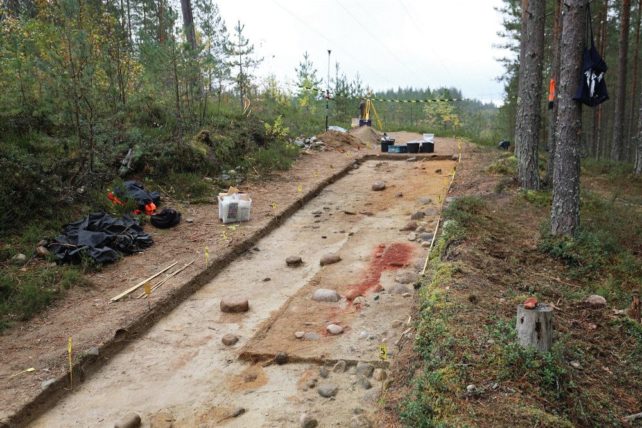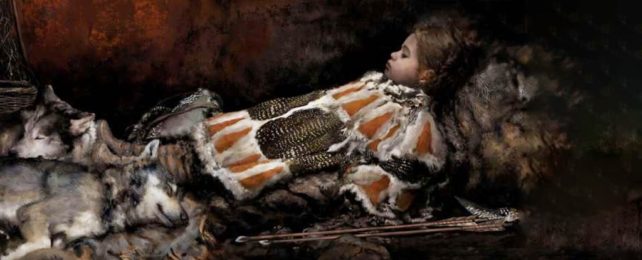Eight thousand years ago, tragedy struck a Stone Age community living in what is now Majoonsuo in Finland – the death of a beloved child. An analysis of their grave reveals the pomp and grandeur of that child's burial: a final resting place that included feathers, fur, and rare plant fibers.
These samples are the first fur and feathers found in a Mesolithic Finnish burial, giving us new information about funerary rituals in the region, thousands of years ago.
The research also shows us how fragments of organic materials can be preserved in grave dirt for us to find millennia later, if we know how to look for them.
"The method used demonstrates that traces of fur and feathers can be found even in graves several thousands of years old, including in Finland," says archaeologist Kristiina Mannermaa of the University of Helsinki in Finland.
Understanding the cultures of ages past is a bit like putting together a puzzle when most of the pieces are missing. We only have the artifacts that survive the ravages of time; usually, that doesn't include much in the way of organic matter. This is especially true in places like Finland, where high acidity in the soil degrades such material even more thoroughly.
But the new research, led by University of Helsinki archaeologist Tuija Kirkinen, shows that detectable traces of delicate organic grave goods can remain in the soil for thousands of years.

The grave was found under an unsealed road in a forest, first identified by a vivid slash of red ochre against the pale gravel of the road. This was the telltale sign of an ancient burial: the iron rich soil used ritually and artistically in places all over the prehistoric world. An archaeological team was rushed in to excavate the site before it could be damaged.
Not much was found in the way of objects. The bones had long since decayed, leaving behind just a few teeth from a child no more than 10 years of age, and no younger than 3. Two quartz arrowheads and two other objects helped the team date the grave to around 6,000 BCE.
But the soil in the grave was almost completely the original soil that had interred the child, opening up another avenue for study: soil analysis.
The team used water to separate the soil from any organic material therein. Then, they used a number of microscopy techniques to study and identify what they found.
The results are fascinating. The fibers revealed were bast fibers, made from the inner bark of certain plants, such as stinging nettle or willow. These are preserved very poorly in Finnish soil; only one other Finnish bast fiber discovery has been made dating to the Stone Age – the Antrea Net.
With only microscopic fragments remaining, it's impossible to tell what the bast fibers in the Majoonsuo grave were, but they may have been part of a net, cord, or string of some kind.
Animal material was also found: 24 microscopic fragments of bird feathers.
These, the researchers say, are the oldest feathers ever found in Finland. Seven of the fragments were from the down of waterfowl, an order that includes ducks, geese and swans. This could have been from a garment such as a parka that would have been filled with down for warmth, or perhaps from grave bedding on which the child was laid to rest.
Another feather fragment was identified as belonging to a falcon. Perhaps it had formed part of the fletching on the arrows placed in the grave, from which only the quartz arrowheads remained; or perhaps falcon feathers were used to decorate the child's clothing.
Finally, the grave yielded 24 fragments of mammalian hair, most of which were too degraded to identify. But three of the hairs from the foot-end of the grave, the team found, were from some sort of canine, either a dog or a wolf. These could, the researchers say, be from a dog that was buried with the child, perhaps as a companion for the afterlife.
"Dogs buried with the deceased have been found in, for example, Skateholm, a famous burial site in southern Sweden dating back some 7,000 years," Mannermaa explains.
However, the absence of animal teeth suggests that it's more likely that the fur formed part of the child's burial garb – rich boots of wolfskin, perhaps.
Although the details are tantalizingly scant, the study reveals significantly more about the burial than we would have known otherwise, and from just a few microscopic traces of material. It would therefore, the researchers say, be potentially beneficial to apply such soil analysis to all burial excavations, even – or especially – those with poor preservation of organic materials.
"This all gives us a very valuable insight about burial habits in the Stone Age," Kirkinen says, "indicating how people had prepared the child for the journey after death."
The research has been published in PLOS ONE.
